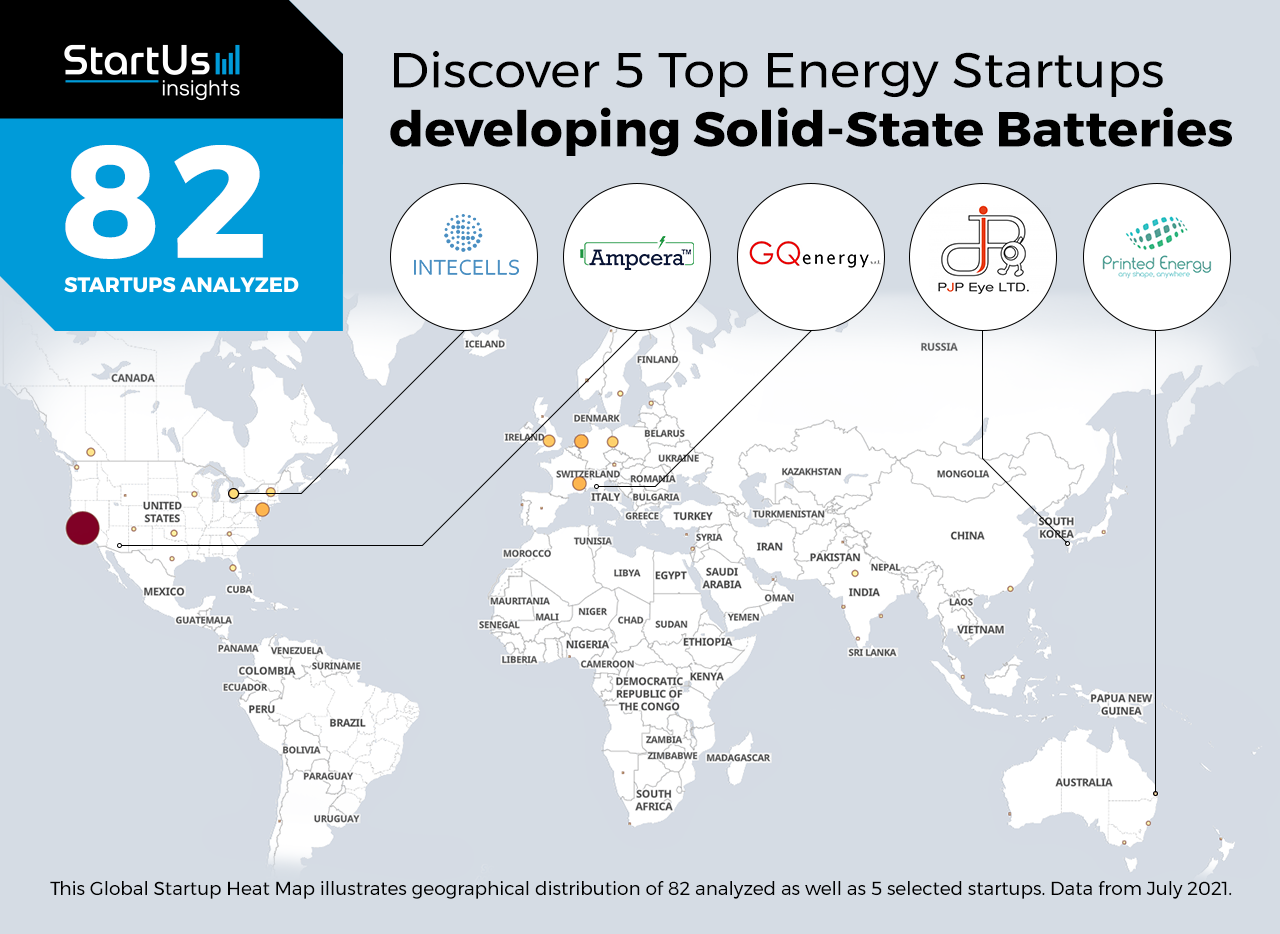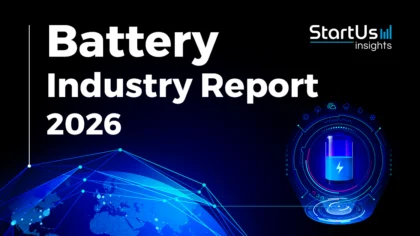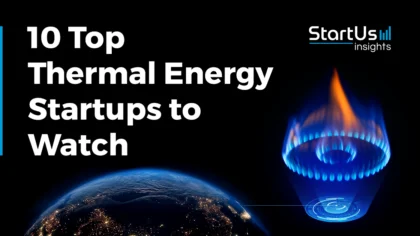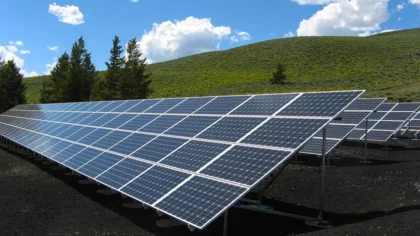Accelerate Productivity in 2025
Reignite Growth Despite the Global Slowdown
Staying ahead of the technology curve means strengthening your competitive advantage. That is why we give you data-driven innovation insights into the energy industry. This time, you get to discover 5 hand-picked startups developing solid-state batteries.
Global Startup Heat Map highlights 5 Top Startups developing Solid-State Batteries out of 82
The insights of this data-driven analysis are derived from the Big Data & Artificial Intelligence-powered StartUs Insights Discovery Platform, covering 2.093.000+ startups & scaleups globally. The platform gives you an exhaustive overview of emerging technologies & relevant startups within a specific field in just a few clicks.
The Global Startup Heat Map below reveals the distribution of the 82 exemplary startups & scaleups we analyzed for this research. Further, it highlights 5 energy startups that we hand-picked based on criteria such as founding year, location, funding raised, and more. You get to explore the solutions of these 5 startups & scaleups in this report. For insights on the other 77 startups developing solid-state batteries solutions, get in touch.
Ampcera develops Solid-State Electrolytes (SSE)
Conventional batteries, such as lithium-ion batteries, usually have liquid electrolytes. However, they provide limited energy densities and pose safety risks. Solid-state batteries (SSB) are emerging as a more energy-dense and safer alternative. These batteries use solid metals, polymers, or glass as electrodes and provide higher mechanical and thermal stability and cyclability.
Ampcera is a US-based startup that develops solid-state batteries as well as materials for them. It engineers SSE materials, including those based on sulfides, garnet-structure oxides, and nasicon-type phosphates. The startup’s solutions enable the incorporation of ultra-fast charging in electric vehicles (EVs). Moreover, the startup’s batteries have better safety and long-term stability as compared to traditional EV batteries.
GQenergy makes a Graphene Battery
A major limitation of conventional batteries is that they take relatively too long to charge. For instance, compared to filling petrol or diesel tanks within minutes, electrical vehicles need to be charged for hours. Graphene offers higher electrical conductivity as well as acts like a supercapacitor. This is why startups are developing graphene-based materials to create solid-state batteries for high-capacity applications with fast charging times.
Italian startup GQenergy designs and manufactures solid-state graphene batteries. The startup’s battery packs an energy density of 252 Wh/kg and delivers 10. It builds QLisa, a table lamp that uses an internal battery that features a stack of solid cells connected through a closed circuit. Its design does not require connecting wires by allowing transmission of current between the power supply and the conductive chassis. Other than household devices, the startup is also investigating solid-state battery solutions for transport and public lighting.
Printed Energy provides Printed Batteries
As devices become smaller, there is a greater demand for flexible electronics that allow designers to shape them in different ways. However, they are limited by a lack of energy storage options with flexible geometries. Unlike liquid batteries, the chemistries of solid-state batteries are amenable to printing techniques. This opens up applications ranging from miniature sensors to wearable electronics.
Australian startup Printed Energy offers thin and flexible printed batteries and photovoltaics. Its proprietary battery chemistries enable the printing of solid-state batteries using roll-to-roll printing techniques common in paper and textile industries. The startup’s batteries utilize metals such as zinc and manganese oxides, as well as the combination of inorganic matrix structures with polymers.
PJP Eye offers Carbon Batteries
For consumer applications, advancements have largely focused on energy-efficient processors rather than on longer-lasting batteries. Startups are developing solid-state batteries that use carbon as one or both electrodes and last longer. They also enable structural batteries where the battery is embedded or laminated into the device or chassis, further reducing weight. Moreover, using carbon makes battery manufacturing more sustainable as compared to using lithium or cobalt.
PJP Eye is a Japanese startup that manufactures solid-state carbon batteries. Its single carbon batteries use metal oxides and carbon for positive and negative electrodes, respectively. It also offers dual carbon batteries that use carbon for both electrodes. The startup’s solutions enable high energy density applications for micro-mobility, drones, portable energy, and energy management.
Intecells manufactures SSBs via Cold Plasma Tech
In recent years, EVs have become more affordable and present a viable alternative to fossil fuel-based mobility. However, range anxiety limits their wider adoption as drivers worry about charging stations, particularly when driving outside cities. Solid-state batteries address this concern by providing higher energy density. They are also lighter than liquid batteries, further improving the efficiency of EVs.
US-based startup Intecells develops a solid-state battery manufacturing technology. Using cold plasma technology, it produces more energy-dense and adaptable EV batteries. Its electrode design utilizes only materials that directly contribute to battery capacity. In addition to this, the solid-state binder-free process and single process manufacturing minimize waste during production, reducing the costs of batteries.
Discover more Energy Startups
Energy startups such as the examples highlighted in this report focus on thin-film batteries, industrial energy storage, and fuel cells. While all of these technologies play a major role in advancing the energy industry, they only represent the tip of the iceberg. To explore more energy technologies, simply get in touch to let us look into your areas of interest. For a more general overview, you can download our free Energy Innovation Report to save your time and improve strategic decision-making.








